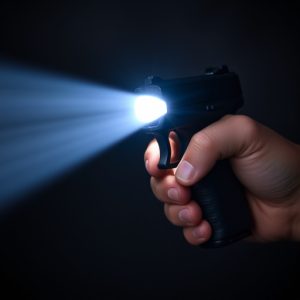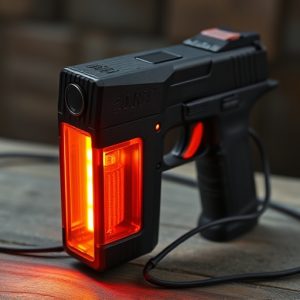Runt Stun Gun vs Kubaton: A Comparative Guide to Personal Protection Tools
The article contrasts two self-defense tools, the Runt stun gun and the Kubaton, noting their disti…….
The article contrasts two self-defense tools, the Runt stun gun and the Kubaton, noting their distinct features and suitabilities for personal protection. The Runt stun gun is a keychain-sized device emphasizing portability and ease of use, with long battery life and LED indicators for power monitoring. It's designed for discreet carry and delivers a powerful electric shock to incapacitate attackers non-lethally. The Kubaton, on the other hand, is a traditional martial arts tool ideal for close combat, offering precise strikes and pressure point manipulation due to its ergonomic design and firm grip. Users must consider their personal defense strategy, training background, and local laws when choosing between these tools, as both have different advantages—the Runt for those prioritizing non-lethal, concealable self-defense, and the Kubaton for individuals with martial arts experience or in situations where close-quarters combat is likely. Legal restrictions and the necessity for comprehensive training on the use of stun guns like the Runt are crucial considerations for responsible ownership.
When it comes to personal defense, the choice between a Runt stun gun and a Kubaton can be pivotal. Both devices offer robust self-defense solutions, but they differ significantly in design, effectiveness, and legal standing. This article delves into the distinctions between these two formidable tools, highlighting their unique applications and the critical aspects that set them apart. We will explore the Runt stun gun’s capabilities within self-defense scenarios, its legal considerations, and how it compares to the Kubaton’s design optimized for close quarters combat. Understanding these elements is crucial for anyone considering either device as a means of personal protection.
Runt Stun Gun vs Kubaton: Understanding the Key Differences and Applications
When comparing the Runt stun gun with the Kubaton, it’s crucial to consider their design, functionality, and practical applications for self-defense. The Runt stun gun is a compact and keychain-sized device engineered for ease of carry and accessibility in tight spaces or during covert operations. Its diminutive size belies its potent capabilities, delivering a high-voltage electric shock to incapacitate an assailant. Designed with user safety in mind, the Runt stun gun is a reliable tool for personal protection, offering a long-lasting charge and clear LED status indicators for battery life.
On the other hand, the Kubaton is a traditional self-defense tool derived from Aikido training, designed to be gripped and used as an extension of the user’s hand. It serves multiple purposes, including striking, grappling, and pressure point application. The Kubaton’s robust construction allows for effective self-defense maneuvers, particularly in close-quarters combat situations. While both devices are intended for personal safety, the Kubaton’s design is more focused on martial arts techniques and pressure point strikes, which can be a critical component of an individual’s self-defense strategy when trained properly. Both the Runt stun gun and the Kubaton offer effective options for personal protection, with the choice between them depending on the user’s specific needs, training, and legal considerations in their jurisdiction.
Effectiveness and Legal Considerations: The Runt Stun Gun in Self-Defense Scenarios
When considering the effectiveness of a runt stun gun in self-defense scenarios, it’s crucial to evaluate both its capabilities and limitations. The runt stun gun is designed as a compact and concealable self-defense tool, offering users an alternative to larger stun devices or traditional firearms. Its diminutive size allows for easy carry without drawing attention, making it an ideal choice for individuals who prioritize discretion in their personal security strategies. The effectiveness of the runt stun gun is tied to its ability to incapacitate an attacker by delivering a high-voltage electric shock that can disrupt muscle control and cause significant pain, potentially ending an assault. This non-lethal force can be a game-changer in situations where verbal warnings fail to deter an aggressor.
However, the legal considerations surrounding the use of a runt stun gun are as important as its effectiveness. Laws governing the possession and use of stun guns vary by jurisdiction, with some areas having stringent regulations that may limit who can own one or where it can be carried. Users must familiarize themselves with local laws to ensure they are in compliance when purchasing, carrying, or using a runt stun gun for self-defense. Additionally, understanding the legal implications of deploying such a device is critical, as misuse can lead to legal consequences that range from fines to imprisonment. Proper training on how to use the runt stun gun effectively and within the confines of the law is indispensable for responsible ownership and self-defense readiness.
Comparative Analysis: How the Kubaton's Design Outshines the Runt Stun Gun for Close Quarters Combat
The Kubaton’s design inherently outperforms the Runt stun gun in close quarters combat due to its optimal size and ergonomic structure, which allows for precise strikes and effective defense. Measuring approximately 6 inches in length with a diameter of less than one inch, the Kubaton’s compact form factor enables users to wield it with ease, offering a high degree of maneuverability in tight spaces. Its cylindrical shape fits comfortably in the hand, providing a firm grip that is conducive to delivering powerful and accurate blows. This design also accommodates various self-defense techniques, including pressure point strikes, which can be crucial in neutralizing an attacker without resorting to lethal force.
In contrast, while the Runt stun gun offers a more discreet and compact option for personal defense, it may fall short in certain aspects of close quarters combat when compared to the Kubaton. The Runt’s design, though small enough to conceal and carry conveniently, might not offer the same level of control and precision as the Kubaton. Its size can sometimes work against the user in situations where precise targeting is necessary, which is a critical component in self-defense scenarios. Additionally, the Runt’s ergonomic design, while suitable for its intended use, may not be as universally suited for executing advanced self-defense maneuvers as the Kubaton’s design, which has been refined over time for such purposes. Users who prioritize versatility and efficacy in tight quarters will often find the Kubaton to be the superior choice among these two devices.


